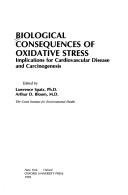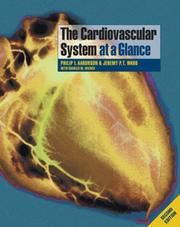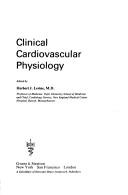| Listing 1 - 6 of 6 |
Sort by
|

ISBN: 0195072960 Year: 1992 Publisher: New York Oxford University Press
Abstract | Keywords | Export | Availability | Bookmark
 Loading...
Loading...Choose an application
- Reference Manager
- EndNote
- RefWorks (Direct export to RefWorks)

ISBN: 9781405113274 1405113278 Year: 2004 Publisher: Malden Blackwell
Abstract | Keywords | Export | Availability | Bookmark
 Loading...
Loading...Choose an application
- Reference Manager
- EndNote
- RefWorks (Direct export to RefWorks)
This concise and accessible systems-based text provides an integrated overview which considers both the basic sciences and clinical applications of the cardiovascular system. A general introduction to the cardiovascular system is followed by anatomy and histology, blood and body fluids, biochemistry and excitation& contraction coupling, form and function, integration and regulation, and pathology and therapeutics. The Cardiovascular System at a Glance is a perfect introduction and revision aid to understanding the heart and circulation and now also features: An extended section of self-assessment clinical cases to aid revision and illustrate clinical relevance Up-to-date information on pharmacology of the cardiovascular system Expanded material on history and examination and increased detail on ECG of arrhythmias Highly visual colour presentation
Blood physiology. Circulatory physiology --- Pathology of the circulatory system --- Cardiovascular Diseases --- Cardiovascular System --- Cardiovascular Physiological Phenomena --- Cardiovascular system --- anatomy and histology --- Physiology --- Pathophysiology --- Cardiovascular Diseases. --- Cardiovascular Physiology. --- Pathophysiology. --- Physiology. --- anatomy & histology. --- Cardiovascular System - anatomy and histology --- Cardiovascular system - Physiology --- Cardiovascular system - Pathophysiology --- Anatomy & histology.
Book
ISBN: 0387888799 9786612126994 1282126997 0387888802 Year: 2009 Publisher: New York ; London : Springer,
Abstract | Keywords | Export | Availability | Bookmark
 Loading...
Loading...Choose an application
- Reference Manager
- EndNote
- RefWorks (Direct export to RefWorks)
Over the last decade, there has been a tremendous improvement in our understanding of basic cardiac electrophysiology. Most introductory electrocardiogram (ECG) books teach via pattern recognition and do not incorporate new pathophysiologic information. There is a great need for a simple book that teaches electrocardiography from a pathophysiologic basis. ECG Interpretation: From Pathophysiology to Clinical Application has been written to fill this gap. It can be utilized as a reference - chapter by chapter or read throughout for an overview. Each chapter will end with questions that provide a chapter review. Case studies are highlighted at the end of the book that integrate the multiple principles of electrocardiography. Fred Kusumoto, MD is Associate Professor of Medicine, Electrophysiology and Pacing Service, Division of Cardiovascular Diseases, Department of Medicine, Mayo Clinic, Jacksonville, Florida.
Cardiovascular system -- Pathophysiology. --- Heart -- Diseases. --- Heart -- Pathophysiology. --- Heart Diseases -- Physiopathology. --- Heart Function Tests --- Electrodiagnosis --- Diagnostic Techniques, Cardiovascular --- Diagnostic Techniques and Procedures --- Diagnosis --- Analytical, Diagnostic and Therapeutic Techniques and Equipment --- Electrocardiography --- Medicine --- Health & Biological Sciences --- Cardiovascular Diseases --- Electrocardiography. --- Heart --- Diseases --- Diagnosis. --- ECG --- EKG --- Electrocardiograms --- Medicine. --- Cardiology. --- Medicine & Public Health. --- Electric properties --- Internal medicine
Book
ISBN: 9784431764281 4431764275 9784431764274 443199839X 9786612019869 1282019864 4431764283 Year: 2008 Publisher: [Tokyo] : Springer,
Abstract | Keywords | Export | Availability | Bookmark
 Loading...
Loading...Choose an application
- Reference Manager
- EndNote
- RefWorks (Direct export to RefWorks)
It is my great pleasure to publish New Frontiers in Lifestyle-Related Dis eases, the proceedings of the Showa University International Symposium for Life Sciences, 3rd Annual Meeting, held at Showa University on Sep tember 13, 2006. This symposium was supported, in part, by Grants for the Promotion of the Advancement of Education and Research in Graduate Schools and Ordinary Expenses for Private Schools from the Ministry of Education, Culture, Sports, Science, and Technology of Japan. On behalf of Showa University, I would like to express my deepest thanks to all the authors and editors for their great contribution to the publication of this memorable book that accelerates research activity in lifestyle-related diseases. Akiyoshi Hosoyamada, M.D., Ph.D. President, Showa University Tokyo, Japan September 2007 v Preface The leading cause of death in Western countries and some developing countries is atherosclerotic cardiovascular diseases. Among them, acute myocardial infarction is the most common type of fatal disease, caused by the progression of atherosclerosis characterized by accumulation of choles terol in vascular walls. Development of atherosclerosis is greatly enhanced by major risk factors for cardiovascular diseases such as obesity, hyperlip idemia, diabetes (hyperglycemia), and hypertension. Among those, obesity frequently initiates a metabolic change that subsequently induces hyperlip idemia, diabetes, hypertension, and eventually atherosclerotic cardiovascu lar diseases. Because obesity and its related disorders largely depend on lifestyle factors such as high calorie intake and low physical activity, a series of disorders are termed lifestyle-related diseases.
Medicine & Public Health. --- Medical Biochemistry. --- Endocrinology. --- Medicine. --- Biochemistry. --- Médecine --- Endocrinologie --- Biochimie --- Atherosclerosis -- Congresses. --- Atherosclerosis -- metabolism -- Congresses. --- Cardiovascular system -- Pathophysiology -- Congresses. --- Cholesterol, LDL -- metabolism -- Congresses. --- Coronary Disease -- metabolism -- Congresses. --- Homeostasis -- physiology -- Congresses. --- Risk Factors -- Congresses. --- Sleep Apnea Syndromes -- metabolism -- Congresses. --- Cardiovascular system --- Atherosclerosis --- Pathophysiology --- Circulatory system --- Vascular system --- Internal medicine. --- Medical biochemistry. --- Internal Medicine. --- Blood --- Circulation --- Internal medicine --- Hormones --- Biological chemistry --- Chemical composition of organisms --- Organisms --- Physiological chemistry --- Biology --- Chemistry --- Medical sciences --- Medicine, Internal --- Medicine --- Composition --- Endocrinology . --- Medical biochemistry --- Pathobiochemistry --- Pathological biochemistry --- Biochemistry --- Pathology

ISBN: 0808909142 9780808909149 Year: 1976 Publisher: New York
Abstract | Keywords | Export | Availability | Bookmark
 Loading...
Loading...Choose an application
- Reference Manager
- EndNote
- RefWorks (Direct export to RefWorks)
Pathological physiology. Pathogenesis --- Pathology of the circulatory system --- Cardiovascular System --- Cardiovascular system --- physiology --- physiopathology --- Diseases --- Pathophysiology --- Cardiovascular Physiological Phenomena. --- -Cardiovascular system --- -Circulatory system --- Vascular system --- Blood --- Cardiovascular Physiological Concepts --- Cardiovascular Physiological Phenomenon --- Cardiovascular Physiological Process --- Physiology, Cardiovascular --- Cardiovascular Physiologic Processes --- Cardiovascular Physiological Processes --- Cardiovascular Physiology --- Cardiovascular Physiological Concept --- Cardiovascular Physiological Phenomenas --- Concept, Cardiovascular Physiological --- Concepts, Cardiovascular Physiological --- Phenomena, Cardiovascular Physiological --- Phenomenon, Cardiovascular Physiological --- Physiologic Processes, Cardiovascular --- Physiological Concept, Cardiovascular --- Physiological Concepts, Cardiovascular --- Physiological Phenomena, Cardiovascular --- Physiological Phenomenon, Cardiovascular --- Physiological Process, Cardiovascular --- Physiological Processes, Cardiovascular --- Process, Cardiovascular Physiological --- Processes, Cardiovascular Physiologic --- Processes, Cardiovascular Physiological --- physiopathology. --- Circulation --- -physiopathology. --- Cardiovascular Physiological Phenomena --- Cardiovascular diseases --- Cardiovascular System - physiology --- Cardiovascular System - physiopathology --- Cardiovascular system - Diseases --- Cardiovascular system - Pathophysiology
Book
ISBN: 162703868X 161779905X 9786613768735 1617799068 1280997125 Year: 2012 Publisher: New York : Humana Press,
Abstract | Keywords | Export | Availability | Bookmark
 Loading...
Loading...Choose an application
- Reference Manager
- EndNote
- RefWorks (Direct export to RefWorks)
Molecular and Translational Vascular Medicine will serve as a state-of-the-art resource for physicians and translational medical researchers alike who are interested in the rapidly evolving field of vascular medicine. The text provides new insight into the basic mechanisms of classic vascular pathophysiologic processes like angiogenesis, atherosclerosis, thrombosis, and vasculitis. Furthermore, it covers new areas of investigation including the role of the ubiquitin proteasome system in vascular disease, endothelial progenitor cells for disease treatment, and the genetic basis of thoracic aortic aneurysms. Lastly, this volume includes sections on the newly emerging field of therapeutic angiogenesis, and the developing technology of nanoparticle-based imaging and therapeutic treatment of the diseased vasculature. All chapters are written by established experts in their fields, including pathologists, cardiovascular surgeons, and internists as well as translational biomedical researchers in a wide range of disciplines. While comprehensive, the material is presented in a manner that simplifies the complex pathophysiologic mechanisms that underlie common vascular diseases. Molecular and Translational Vascular Medicine will be of great value to a broad audience including internists, cardiovascular and vascular surgeons, pathologists, residents and fellows, as well as translational biomedical researchers.
Cardiovascular system -- Aging. --- Cardiovascular system -- Pathophysiology. --- Molecular biology. --- Cardiovascular system --- Cardiovascular Diseases --- Diseases --- Vascular Diseases --- Medicine --- Health & Biological Sciences --- Pathology --- Pathophysiology --- Blood-vessels --- Medical genetics. --- Pathology, Molecular. --- Medical innovations. --- Diseases. --- Treatment. --- Innovations, Medical --- Molecular pathology --- Molecular biochemistry --- Molecular biophysics --- Clinical genetics --- Heredity of disease --- Angiology --- Vascular system --- Vasculature --- Vascular diseases --- Innovations --- Technological innovations --- Genetic aspects --- Medicine. --- Cardiology. --- Pathology. --- Medicine & Public Health. --- Molecular Medicine. --- Biochemistry --- Biophysics --- Biomolecules --- Systems biology --- Medical technology --- Molecular biology --- Physiology, Pathological --- Human genetics --- Medical sciences --- Genetic disorders --- Clinical sciences --- Medical profession --- Human biology --- Life sciences --- Physicians --- Heart --- Internal medicine --- Disease (Pathology) --- Medicine, Preventive --- Health Workforce
| Listing 1 - 6 of 6 |
Sort by
|

 Search
Search Feedback
Feedback About UniCat
About UniCat  Help
Help News
News